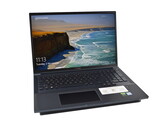
Asus ProArt StudioBook Pro X W730G5T laptop review: Too expensive for a hexa-core workstation
Intel Xeon E-2276M | NVIDIA Quadro RTX 5000 (Laptop) | 17.00" | 2.9 kg
The Nvidia Quadro RTX 5000 for laptops is a professional high-end graphics card for big and powerful laptops and mobile workstations. It is based on the same TU104 chip as the consumer GeForce RTX 2080 (mobile) but offers more shaders (128 more). Compared to the desktop RTX 5000, the mobile variant offers lower clock speeds. There are different versions available with 110 Watt (1035 - 1545 MHz) and 150 Watt (1350 - 1770 MHz) in addition to the even lower clocked Max-Q variant.
| Model | TGP (W) | Base (MHz) | Boost (MHz) |
| Quadro RTX 5000 Desktop | 230 | 1620 | 1815 |
| Quadro RTX 5000 Mobile | 150 | 1350 | 1770 |
| Quadro RTX 5000 Mobile | 110 | 1035 | 1545 |
| Quadro RTX 5000 Max-Q | 90 | 930 | 1455 |
| Quadro RTX 5000 Max-Q | 85 | 765 | 1395 |
| Quadro RTX 5000 Max-Q | 80 | 600 | 1350 |
The Quadro GPUs offer certified drivers, which are optimized for stability and performance in professional applications (CAD, DCC, medical, prospection, and visualizing applications). The performance in these areas is therefore much better compared to corresponding consumer GPUs.
Features
NVIDIA manufacturers the TU104 chip on a 12 nm FinFET process and includes features like Deep Learning Super Sampling (DLSS) and Real-Time Ray Tracing (RTRT), which should combine to create more realistic lighting effects than older GPUs based on the company's Pascal architecture (if the games support it). The Quadro RTX 5000 is also DisplayPort 1.4 ready, while there is also support for HDMI 2.0b, HDR, Simultaneous Multi-Projection (SMP) and H.265 video en/decoding (PlayReady 3.0).
Performance
Depending on the application or game, the Quadro RTX 5000 is even faster than the GeForce RTX 2080 and therefore the fastest mobile graphics card. Especially for some professional apps and workflows that make use of the large VRAM, the Quadro can best the RTX2080 clearly.
The high power consumption of the RTX5000 makes the card most suited for big and heavy laptops. The slower Max-Q variant is intended for thinner laptops.
Quadro Turing Series
| ||||||||||||||||||||||||||||||||||||||||||||||||||||
| Codename | N19E-Q5 | |||||||||||||||||||||||||||||||||||||||||||||||||||
| Architecture | Turing | |||||||||||||||||||||||||||||||||||||||||||||||||||
| Pipelines | 3072 - unified | |||||||||||||||||||||||||||||||||||||||||||||||||||
| Core Speed | 1035 / 1350 - 1545 / 1770 (Boost) MHz | |||||||||||||||||||||||||||||||||||||||||||||||||||
| Memory Speed | 14000 MHz | |||||||||||||||||||||||||||||||||||||||||||||||||||
| Memory Bus Width | 256 Bit | |||||||||||||||||||||||||||||||||||||||||||||||||||
| Memory Type | GDDR6 | |||||||||||||||||||||||||||||||||||||||||||||||||||
| Max. Amount of Memory | 16 GB | |||||||||||||||||||||||||||||||||||||||||||||||||||
| Shared Memory | no | |||||||||||||||||||||||||||||||||||||||||||||||||||
| API | DirectX 12_1, OpenGL 4.6 | |||||||||||||||||||||||||||||||||||||||||||||||||||
| Power Consumption | 110 / 150 Watt | |||||||||||||||||||||||||||||||||||||||||||||||||||
| Transistor Count | 13.6 Billion | |||||||||||||||||||||||||||||||||||||||||||||||||||
| technology | 12 nm | |||||||||||||||||||||||||||||||||||||||||||||||||||
| Features | NVLink, DLSS, Raytraycing, VR Ready, G-SYNC, Vulkan, Multi Monitor | |||||||||||||||||||||||||||||||||||||||||||||||||||
| Notebook Size | large | |||||||||||||||||||||||||||||||||||||||||||||||||||
| Date of Announcement | 27.05.2019 | |||||||||||||||||||||||||||||||||||||||||||||||||||
The following benchmarks stem from our benchmarks of review laptops. The performance depends on the used graphics memory, clock rate, processor, system settings, drivers, and operating systems. So the results don't have to be representative for all laptops with this GPU. For detailed information on the benchmark results, click on the fps number.























| low | med. | high | ultra | QHD | 4K | |
|---|---|---|---|---|---|---|
| Doom Eternal | 234.5 | 200.2 | 183.7 | 180.8 | 128.5 | 68.6 |
| Hunt Showdown | 231.1 | 163.8 | 130.4 | 87.8 | 77.1 | |
| Escape from Tarkov | 121 | 121 | 120.3 | 110.6 | 106.6 | 53.8 |
| Red Dead Redemption 2 | 145.6 | 125.9 | 87.4 | 54.1 | 43.7 | 28.1 |
| Star Wars Jedi Fallen Order | 112.8 | 112.1 | 107.5 | 89.6 | 50.2 | |
| Need for Speed Heat | 109.9 | 104.9 | 98.7 | 95.9 | 89 | 52.7 |
| Call of Duty Modern Warfare 2019 | 232.6 | 156.2 | 144.9 | 119.3 | 86.6 | 48.8 |
| GRID 2019 | 186.6 | 144.5 | 142.5 | 100.7 | 80.7 | 54.9 |
| Ghost Recon Breakpoint | 152 | 125 | 118 | 88 | 66 | 38 |
| Borderlands 3 | 153.8 | 130.2 | 104.5 | 85.5 | 59.8 | 31.5 |
| Control | 239 | 123.7 | 93.3 | 60.5 | 30.1 | |
| F1 2019 | 243 | 210 | 182 | 144 | 146 | 78 |
| Total War: Three Kingdoms | 222 | 143 | 106 | 77 | 53.3 | 25.9 |
| Rage 2 | 303.8 | 160.4 | 137.1 | 133.8 | 85.8 | 42.2 |
| Anno 1800 | 119.2 | 118.8 | 93.1 | 51.1 | 46.9 | 30.3 |
| The Division 2 | 178 | 156 | 131 | 55 | 55 | 38 |
| Dirt Rally 2.0 | 289.3 | 208.4 | 200.1 | 115.5 | 84.3 | 51.2 |
| Metro Exodus | 161 | 124.4 | 95.2 | 77 | 59.3 | 36.7 |
| Apex Legends | 144 | 144 | 144 | 143.9 | 135 | 76.3 |
| Battlefield V | 187 | 164.6 | 161.7 | 151.9 | 123.9 | 72.7 |
| Assassin´s Creed Odyssey | 113 | 104 | 94 | 73 | 63 | 40 |
| Shadow of the Tomb Raider | 125 | 104 | 101 | 96 | 87 | 47 |
| Far Cry 5 | 150 | 128 | 123 | 115 | 102 | 56 |
| X-Plane 11.11 | 110 | 84.5 | 76.5 | |||
| For Honor | 329.3 | 216.9 | 206.8 | 160.4 | 68.4 | |
| Rainbow Six Siege | 350.2 | 296.1 | 279.6 | 266.2 | 138 | |
| Dota 2 Reborn | 144 | 132 | 97.5 | 92 | ||
| The Witcher 3 | 305 | 263 | 181 | 100 | 71 | |
| BioShock Infinite | 458 | 396.9 | 367.9 | 216.3 | ||
| Tomb Raider | 757 | 681 | 625 | 319.6 | ||
| low | med. | high | ultra | QHD | 4K | < 30 fps < 60 fps < 120 fps ≥ 120 fps | 4 25 | 6 24 | 13 17 | 3 15 9 | 6 13 4 | 2 16 7 1 |
For more games that might be playable and a list of all games and graphics cards visit our Gaming List


Acer ConceptD 7 Ezel Pro CC715-91P-X92: Intel Xeon W-10885M, 15.60", 2.5 kg
External Review » Acer ConceptD 7 Ezel Pro CC715-91P-X92
Asus ProArt StudioBook Pro X W730G5T-H8103R: Intel Xeon E-2276M, 17.30", 2.5 kg
External Review » Asus ProArt StudioBook Pro X W730G5T-H8103R
Acer ConceptD 7 Pro CN715-71P-73YL: Intel Core i7-9750H, 15.60", 2.1 kg
External Review » Acer ConceptD 7 Pro CN715-71P-73YL
Dell Precision 7540 Xeon E2286M, RTX 5000: unknown, 15.60", 2.5 kg
External Review » Dell Precision 7540 Xeon E2286M, RTX 5000
HP ZBook 17 G6, Xeon E-2286, RTX 5000: unknown, 17.30", 3.2 kg
External Review » HP ZBook 17 G6, Xeon E-2286, RTX 5000
Acer ConceptD 7 Pro CN715-71P-75G8: Intel Core i7-9750H, 15.60", 2.1 kg
External Review » Acer ConceptD 7 Pro CN715-71P-75G8
MSI WS65 9TM-857: Intel Core i9-9880H, 15.60", 1.9 kg
External Review » MSI WS65 9TM-857
Asus StudioBook Pro X W730G5T-H8050T: Intel Xeon E-2276M, 17.00", 2.9 kg
External Review » Asus StudioBook Pro X W730G5T-H8050T
Asus ProArt StudioBook Pro X-W730G5T, i7-9750H: Intel Core i7-9750H, 17.00", 2.5 kg
External Review » Asus ProArt StudioBook Pro X-W730G5T, i7-9750H
Acer ConceptD 9 Pro: Intel Core i9-9980HK, 17.30", 4.5 kg
» Acer's creative tool has left us with a good impression - Acer ConceptD 9 Pro CN917-71P in review
» Comparison of GPUs
Detailed list of all laptop GPUs sorted by class and performance.
» Benchmark List
Sort and restrict laptop GPUs based on performance in synthetic benchmarks.
» Notebook Gaming List
Playable games for each graphics card and their average FPS results.
Top 10 Laptops
Multimedia, Budget Multimedia, Gaming, Budget Gaming, Lightweight Gaming, Business, Budget Office, Workstation, Subnotebooks, Ultrabooks, Chromebooks
under 300 USD/Euros, under 500 USD/Euros, 1,000 USD/Euros, for University Students, Best Displays
Top 10 Smartphones
Smartphones, Phablets, ≤6-inch, Camera Smartphones